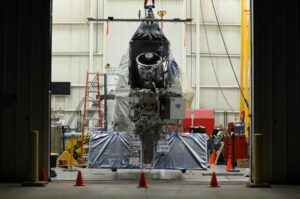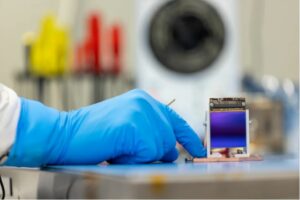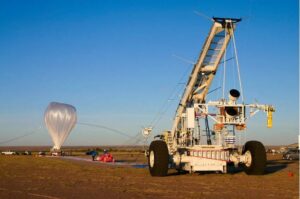NASA scientists say the EXCITE (EXoplanet Climate Infrared Telescope) Mission is preparing to launch from Antarctica to study the atmospheres of distant exoplanets from the edge of space. Perched atop a helium-filled balloon that will lift the telescope above 99.5% of Earth’s atmosphere, EXCITE is first scheduled for a series of test flights this fall before ultimately launching from Antarctica for its designated mission.
According to a statement from the space agency, EXCITE is designed to stay above Earth’s South Pole so it can perform continuous observations of distant, Jupiter-like exoplanets. Making these types of observations using current space-based observatories like the James Webb Space Telescope (JWST) is costly and rare, they explain, so the EXCITE mission can offer particularly valuable data to scientists hoping to better understand and characterize the atmospheric composition and dynamics of planets beyond our solar system.
“EXCITE can give us a three-dimensional picture of a planet’s atmosphere and temperature by collecting data the whole time the world orbits its star,” said Peter Nagler, the mission’s principal investigator at NASA’s Goddard Space Flight Center in Greenbelt, Maryland. “Only a handful of these types of measurements have been done before. They require a very stable telescope in a position to track a planet for several days at a time.”
EXCITE Mission Will Stay above the South Pole for Continuous Observation
Space telescopes offer significant advantages due to the limitations the Earth’s atmosphere places on ground-based observatories. Unfortunately, designing, building, and launching observatories as complex as the JWST, the Hubble Space Telescope, and the Spitzer Space Telescope is time-consuming and costly. As a result, scientists must compete for their use.
For example, in 2014, Hubble and Spitzer worked together to collect detailed observations on the exoplanet WASP-43 b. That effort required 60 hours from Hubble and 46 hours from Spitzer to observe just one of the exoplanet’s 22-hour days.
With EXCITE, NASA says it can reduce costs and increase data collection efficiency by flying an infrared telescope like those used in other space observatories to an altitude of 132,000 ft. As noted, that puts the scientific instrument above 99.5% of the Earth’s atmosphere. NASA says flying that high will allow it to observe multiple infrared wavelengths “with little interference.”


NASA/Jeanette Kazmierczak
Due to its location above the Earth’s South Pole, the mission is also capable of staying locked on a target for extended periods of time. This is especially valuable, as most space telescopes have to start and stop their observations as they orbit the Earth.
“At the pole, the stars we’ll study don’t set, so our observations won’t be interrupted,” explained Kyle Helson, an EXCITE team member and a research scientist at the University of Maryland, Baltimore County, and NASA Goddard.
“Over a Dozen Days” at the Edge of Space
According to Helson, EXCITE’s first mission will keep it aloft “for over a dozen days” after blasting off from the Columbia Scientific Balloon Facility’s site in Antarctica. During that time, it will observe a class of planets known as hot Jupiters. These massive gas giants are tidally locked, meaning one side remains facing its host star. Hot Jupiters also have an orbit length of about two days. According to the press release announcing the mission, this unusually close proximity to the host star means these space bodies have temperatures “in the thousands of degrees.”
While significantly cheaper than a full-blown space observatory, the mission planners caution that EXCITE is still an extremely delicate and sensitive piece of high-powered scientific equipment.
“The telescope collects the infrared light and beams it into the spectrometer, where it kind of goes through a little obstacle course,” said Lee Bernard, an EXCITE team member and a graduate research assistant at Arizona State University in Tempe. “It bounces off mirrors and through a prism before reaching the detector. Everything must be aligned very precisely — just a few millimeters off center, and the light won’t make it.”


Barring a mission failure, the EXCITE team believes their instrument can significantly increase the data available on exoplanet atmospheres. For example, it will record how heat is distributed from the planet’s “scalding” side facing the star to its cooler “nightside.”
The mission planners also hope that the scientific instrument aboard EXCITE can use a process called phase-resolved spectroscopy to determine how molecules in the atmosphere of a hot Jupiter absorb and emit light throughout the planet’s entire orbit. According to NASA, this data can not only reveal the presence of organic compounds like water, methane, and carbon dioxide “but also how they circulate globally as the planet orbits its star.”
“We hope that the mission will effectively double the number of phase-resolved spectra available to the science community,” Helson said.
Successful New Mexico Test Flights Will Pave the Way for Antarctica Launch
According to NASA, EXCITE is currently scheduled for a series of tests planned for the agency’s annual Scientific Balloon Program at Fort Sumner, New Mexico. That program is already underway, with the agency conducting test fights for other potential missions on August 21st and 22nd.
“The annual Fort Sumner campaign is the cornerstone of the NASA Balloon Program operations,” said Andrew Hamilton, acting chief of NASA’s Balloon Program Office. “Not only are we launching a large number of missions, but these flights set the foundation for follow-on missions from our long-duration launch facilities in Antarctica, New Zealand, and Sweden.”


After its first set of tests during the 2023 Balloon Program, EXCITE hopes to take flight in the coming days. If successful, those tests will set the stage for its ultimate Antarctica launch.
“The whole EXCITE team is looking forward to our upcoming field campaign and launch opportunity from Fort Sumner,” said Peter Nagler, principal investigator at NASA’s Goddard Space Flight Center in Greenbelt, Maryland. “We’re bringing a more capable instrument than we did last year and are excited to prove EXCITE from North America before we bring it to the Antarctic for our future long-duration science flight.”
“Several different institutions contributed to EXCITE’s subsystems,” added Tim Rehm, an EXCITE team member and a graduate research assistant at Brown University in Providence, Rhode Island. “It’s great to see them all assembled and working together. We’re excited to do this test flight, and we’re looking forward to all the future science flights we hope to have.”
Christopher Plain is a Science Fiction and Fantasy novelist and Head Science Writer at The Debrief. Follow and connect with him on X, learn about his books at plainfiction.com, or email him directly at christopher@thedebrief.org.

